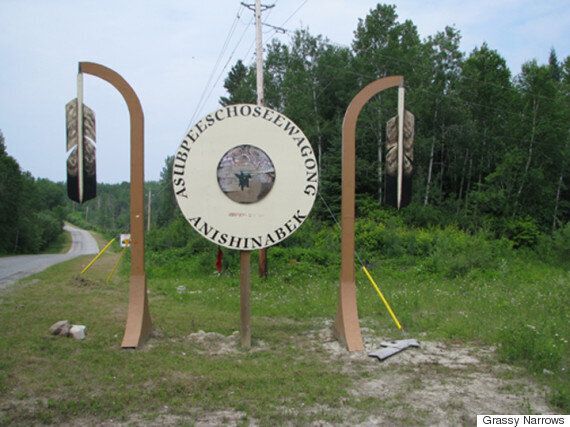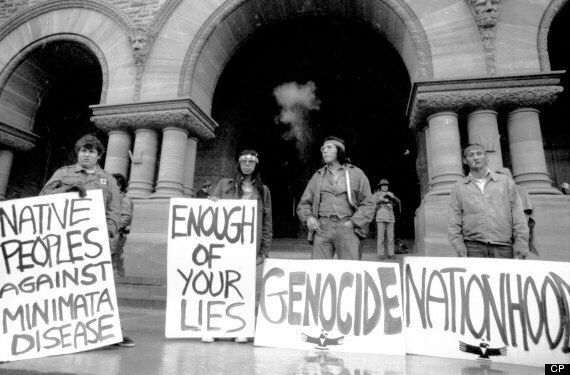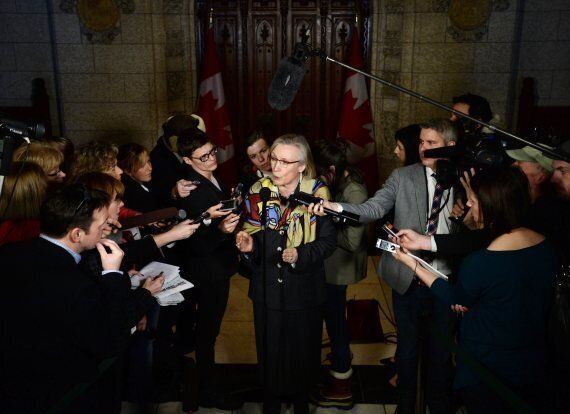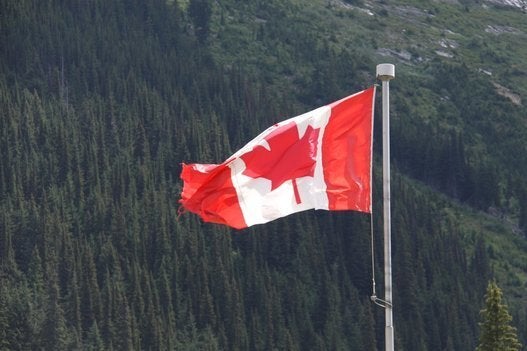
A tub is filled with unsafe water in a Batchewana First Nation home.
An Ontario chief says his remote reserve plagued by unsafe water continues to be on the hook for arranging and paying for bottled water — even though Ottawa is technically responsible for the service.
It’s one example of how the federal government has continually let down Grassy Narrows, said Chief Simon Fobister Sr. in an interview with The Huffington Post Canada.
On Tuesday, Human Rights Watch (HRW) released a 92-page report calling on the Liberal government to take “urgent” steps to address the drinking water issues on some First Nations reserves.
“The water crisis is the result of years of discrimination compounded by lack of accountability,” said Amanda Klasing, senior HRW researcher, in a news release.
“Tainted water and broken systems on Ontario’s First Nations reserves are jeopardizing health, burdening parents and caregivers, and exacerbating problems on reserves.”

Sign outside Grassy Narrows First Nation.
The Liberal government’s promise to end boil-water advisories on reserves within five years — and the $2.2-billion promise it earmarked in the budget to achieve that goal —has yet to produce tangible change in communities.
Where’s the money?
Fobister said he met with Indigenous and Northern Affairs Canada in Thunder Bay last month to talk about the ongoing water crisis that has lowered his community's standard of living for years. Officials told him that Ottawa has yet to to move budget money into the department’s account.
“Department has all this money assigned to them, but it’s not flowing," said Fobister.
The federal government is financially obligated to cover the costs related to the regulation and governance of drinking water on First Nations reserves.

Grassy Narrows protesters demonstrate against mercury poisoning in 1975 on the steps of Queen's Park in Toronto. (Photo: Barrie Davis / The Globe and Mail via The Canadian Press)
Grassy Narrows, approximately 500 kilometres northwest of Thunder Bay, has a long history with unsafe drinking water. In the 1960s, 9,000 kilograms of mercury was dumped in a local river after a paper mill was shut down.
Federal officials at the time — and successive governments — all failed to clean up the toxic mess.
A government supply of bottled water is delivered every day to Grassy Narrows, Fobister explained to HuffPost. But after the shipment is dropped off, it’s up to the band to pay people to monitor the new supply and distribute clean water door-to-door to elders and others unable to do the pick up themselves.
“They have all the money and we don’t.”
— Grassy Narrows Chief Simon Fobister Sr.
It’s a regular bill that adds insult to injury, Fobister said. He doesn’t understand why the government can’t use the money for bottled water toward fixing the reserve’s broken water treatment plant.
“The department is paying for the purchase and delivery of the water to the reserve, but they’re not paying for the distribution for the community. They have all the money and we don’t.”

Indigenous Affairs Minister Carolyn Bennett speaks to reporters on Parliament Hill in February. (Photo: Sean Kilpatrick/The Canadian Press)
Home to approximately 1,000 people, the community has been under a boil-water advisory for nearly three years. Antibiotic-resistant skin diseases have been reported among children who live on the reserve.
Last year, council declared a state of emergency over its unsafe drinking water. Today, water from the treatment plant and two community wells remain under “do not consume” orders.
Respect UN declaration: watchdog
For its report, Human Rights Watch investigated five Ontario First Nations — Batchewana, Grassy Narrows, Neskantaga, Six Nations of the Grand River, and Shoal Lake 40 — all under long-term boil-water orders. Investigators conducted 111 interviews.
First Nations families are worried about the long-term health effects of the water they drink and bathe in will have on their kids, the report said.
It suggested the government of Canada “tackle both the symptoms and the underlying causes.”
The three pages of recommendations includes one that the federal government follow international legal standards and “respect the rights set out in the United Nations Declaration on the Rights of Indigenous Peoples” in relation to access to safe drinking water.
“The water crisis is the result of years of discrimination compounded by lack of accountability.”
Amanda Klasing, Human Rights Watch researcher
Prime Minister Justin Trudeau campaigned on the promise to end boil-water advisories on First Nations within five years — a pledge one expert labelled as “unrealistic."
Lalita Bharadwaj, a public health professor at the University of Saskatchewan, explained to Maclean’s magazine last year that the timeline is problematic because it doesn’t take into account unknown factors:
I’m not sure how Mr. Trudeau has come up with this idea, because the causes are so complex. It could be because the treatment system doesn’t work, or it’s ineffective to treat the water. It could be because the raw water source is contaminated. It could be because the pressure within the piping is not allowing for the delivery of pressurized water to the house, and that would affect the chlorination process. There are a number of factors.
In responding to the HRW report, Indigenous and Northern Affairs Canada spokeswoman Valérie Hache reiterated the government’s pledge to end long-term boil water advisories on reserves within five years.
“We know that there is much more work to be done. INAC will take the time to review the report, and determine the next steps to addressing their recommendations in partnership with First Nations communities," she wrote in an email to HuffPost Canada.
Currently, there are 133 boil-water advisories on 89 First Nation reserves across the country.
Also on HuffPost:
